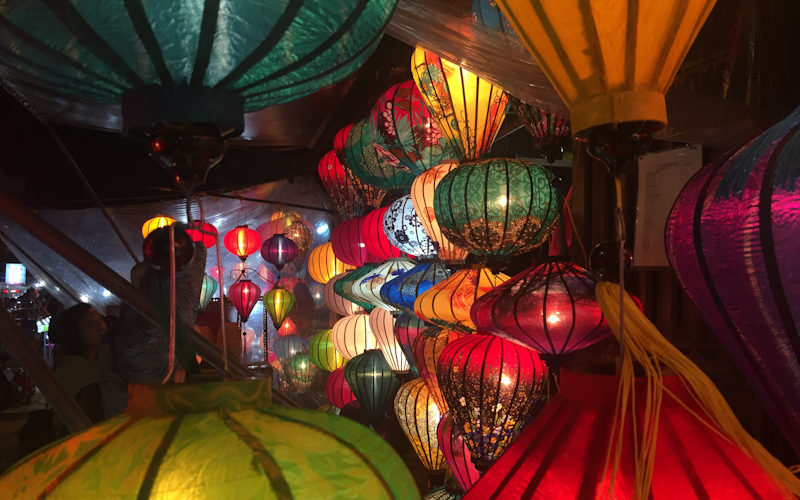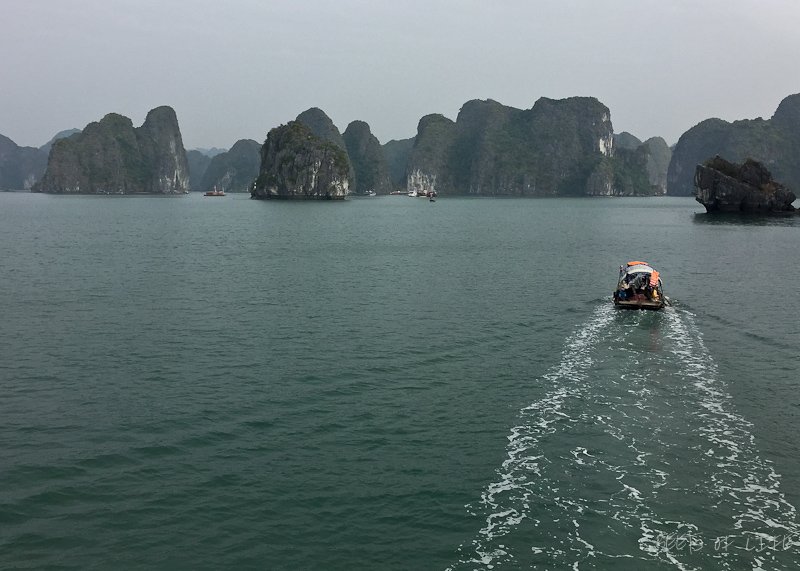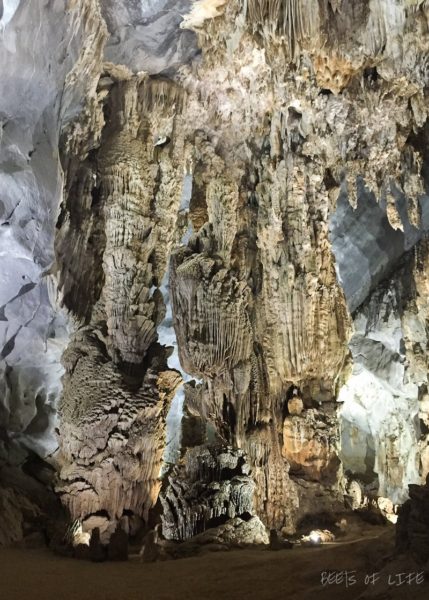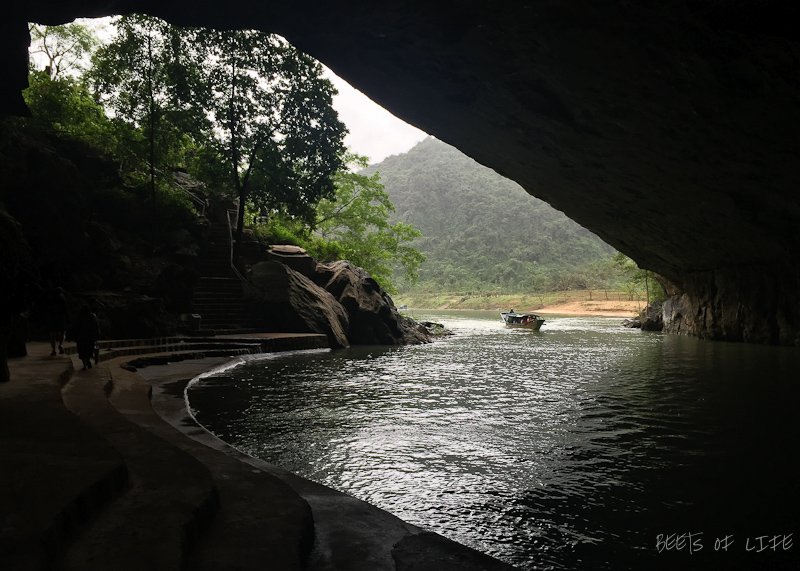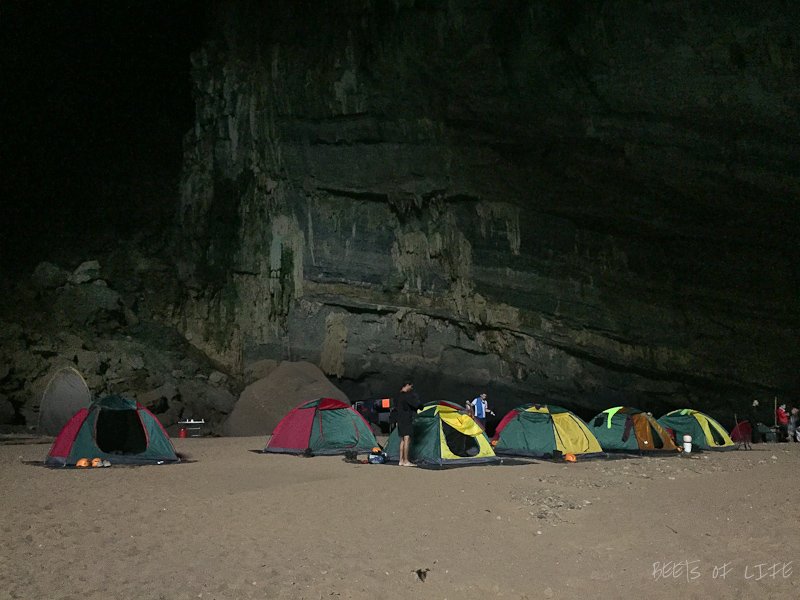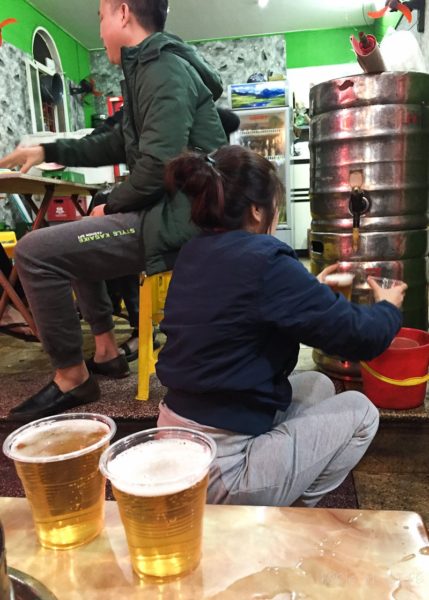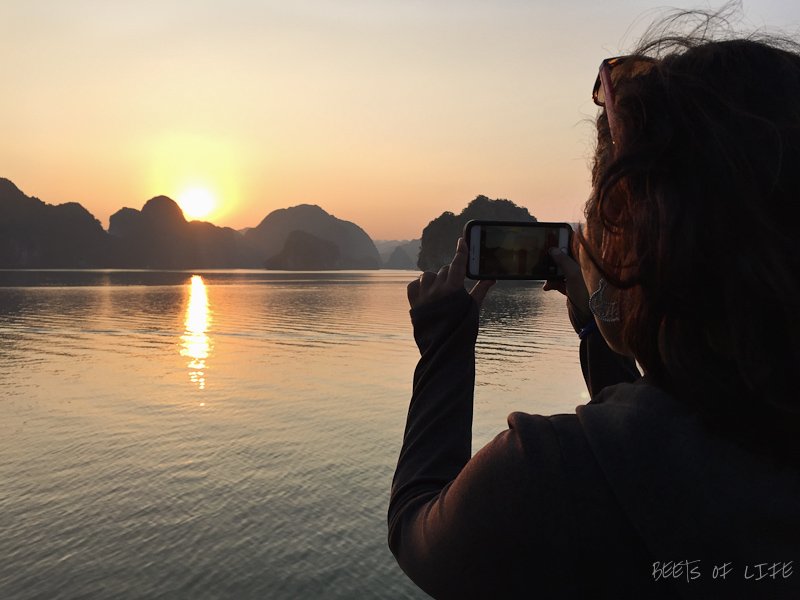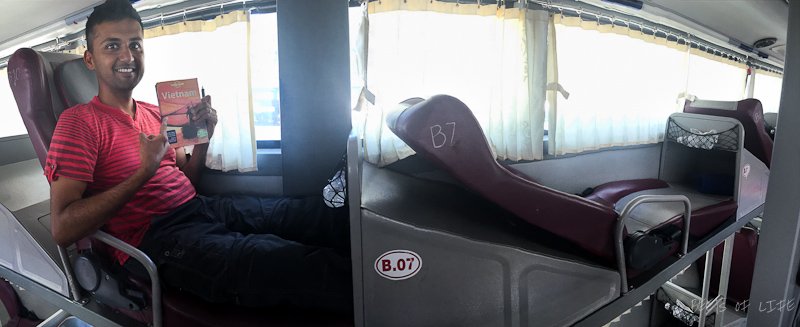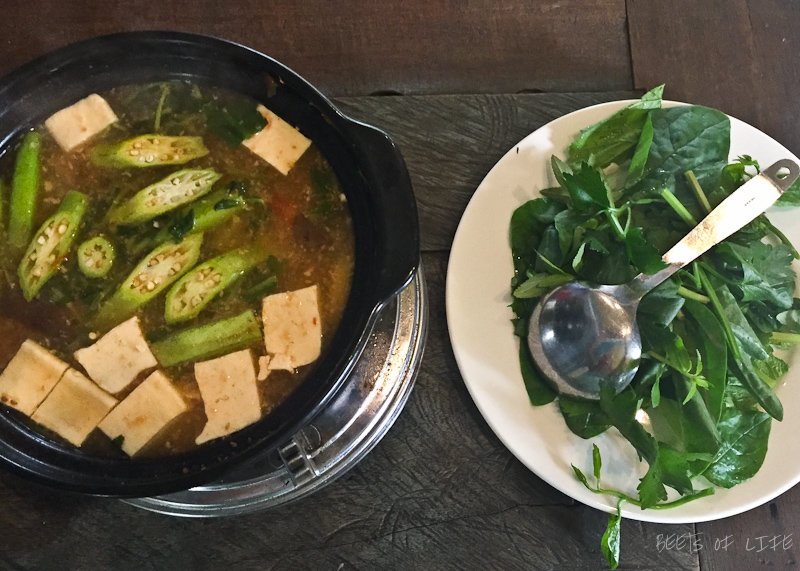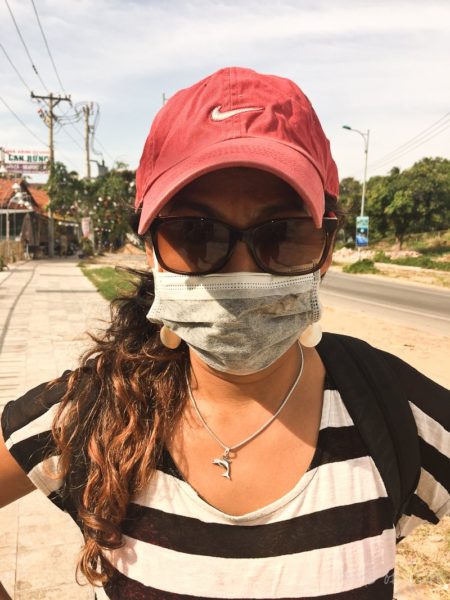Travel Guide for Vietnam
This Travel Guide for Vietnam is a collection of our experiences and research, vegetarian food we ate, what worked for us, tips and recommendations for budget accommodation and transport while traveling across Vietnam over 4 weeks in January, 2017.
Travel Guide for Vietnam:
- Our Itinerary
- Budget Accommodation
- Visa On Arrival with an Indian Passport
- Budget Transportation
- Yoga
- Vegetarian Food
- Sim Card for Phone and Internet
- Currency
- General Tips
- Related Articles
Our Itinerary
On January 1st, 2017 we, literally, walked into Vietnam from Cambodia at the Ha Tien border checkpoint. We didn’t know what to expect from Vietnam when we entered, however, by the time it was time to leave a month later, we felt like we could have stayed on longer. Here is our itinerary in Vietnam:
- Jan 1 – 5: Ho Chi Minh City (HCMC) / Saigon – War Remnants Museum
- Jan 5 – 8: Da Lat – The hill station of South Vietnam
- Jan 9 – 16: Hoi An – UNESCO Heritage Site: Ancient town
- Jan 16 – 19: Phong Nha Ke Bang National Park / Hang En – Adventure of our lives
- Jan 20 – 22: Ha Noi – The capital city
- Jan 22 – 25: Cat Ba – Halong Bay Cruise
- Jan 25 – Feb 1: Phu Quoc – Sun and Sand
We were sad to leave Phu Quoc and Vietnam, and on February 1st we boarded a flight to go to Luang Prabang, Laos.
Budget Accommodation
Ho Chi Minh City:
Long Hostel (Cost: $; Rating: **)
We spent two nights at Long Hostel and stayed in the mixed dorm room. It was $7 per person per night, we didn’t think it was worth it. The positive is that it’s close to backpacker street, and has a pretty good location, it was just a horrible place to stay. They had a very spare room with spare bunk beds. There were no lockers and no privacy of any sort. The room did not even have curtains, which would make it particularly challenging for women.
Furthermore, we were given a room in the building that they were still working on, which meant construction early in the morning with lots of noise, debris and dust. And finally the entire bathroom was leaking water, and I mean water coming from the ceiling, and the tiles on the wall. That was definitely a first. The staff themselves weren’t very friendly. They could have been a lot more communicative about what’s going on. Overall a bad experience, we don’t recommend this place.
Vintage hostel (Cost: $; Rating: ******)
In an absolute contrast to Long Hostel and at almost the same price was Vintage Hostel. It is right on backpacker street and close to a lot of restaurants and coffee shops. We were worried about the noise initially but that was not a bother at all (asking for a higher floor might have helped in that regard). The mixed dorm room was extremely well thought out. Each bed had privacy curtains, plug points, night lights, a large shelf (built in to the wall), and hooks. The staff and other travelers we met there were very friendly. The only negative about this place would have been the bathrooms. They were a little small and dirty. Other than that, we highly recommend this place.

Dalat:
Pizza Tet Hostel (Cost: $$; Rating: ****)
Great value for money. Good hotel about 20 minute walk from the city center. We had a huge private room that consisted of a large bed, wardrobe, and balcony. We noticed they had dorm beds as well, although we didn’t stay there. The rooms sit on a restaurant serving, PIZZA! No surprises there! It’s called pizzatet for a reason. The pizzas were decent, a good option if you are hungry and don’t want to walk. The staff was very friendly and eager to help and answer any questions we had about transport or the area in general.
Hoi An:
Golden Bell Homestay (Cost: $$; Rating: *****)
Pretty exceptional place, that is mid way between the Hoi An ancient town and the beach. We got the private room here and our intial impression was that it was a very well furnished room. This impression was spot on and did not change throughout our stay. We were there for 7 nights. For fellow yogis it is a short bicycle ride to Nomad yoga, a huge plus for us. We went for yoga every single day we were in Hoi An! The staff was friendly and helped us with all our questions. The hotel also provides free bicycles to go about town, clearly making up for the fact that they are a little far (in terms of walking distance) from both the ancient town and the beach. The breakfast spread is one of the best that we have had! Overall, excellent value for money.
Phong Nha:
Linh’s Homestay (Cost: $; Rating: **)
We are unsure of how this place has exceptional reviews. There are only two things that this place has going for it! One is that it’s close to the Phong Nha Ke Bang national park, and two the staff is exceptional, or in particular the one lady is awesome (didn’t catch her name)! She exemplifies service with a smile and went above and beyond to help us, that too with a broken leg.The hotel lobby is sparse and not well lit, not giving you a welcome feeling at all. The rooms and bathrooms were damp and mouldy (could be because it was cloudy and drizzly when we went in January). We felt icky sleeping there and were happy when we changed our plans and ended up cutting a night short. This place lives up to the phrase “you get what you pay for” for all the bad reasons.
Hanoi:
Little Hanoi Diamond (Cost: $$; Rating: ***)
We were here for only two nights, and found this place to be average. The room was spacious and had everything we needed. The bathing area was a tad bit small given that the shower was below my head (I’m only 5ft 8in). Other than that, a pretty decent location. A 15-20 min walk to a lot of restaurants. The staff were also nice and friendly. We got room 101 which is very close to the restaurant. We were woken up one of the nights by loud noises, so that wasn’t great.
Cat Ba:
Phu Thanh Hotel (Cost: $; Rating: ***)
In Cat Ba, we stayed at the Phu Thanh hotel. It was cheap, great value for money, comfortable with excellent views of Lan Ha bay (you can upgrade your room to face the bay). We were in a private room on the 9th floor with two double beds and a partial view of the bay for only $11/night and one level away from the roof top. The panoramic views of the bay from the roof top is the reason we didn’t opt for an upgrade. Overall, the accommodation was great, however, there were very basic facilities at the hotel. They have a restaurant but with not many vegetarian options.
Phu Quoc:
Sunshine Bungalows (Cost: $$$; Rating: *****)
Possibly one of the best places that we have stayed in our travels, we loved our stay at Sunshine Bungalow. We were upgraded to the Deluxe Bungalow room and were there for 7 nights. The room was clean, and came equipped with towels, a safe, hair dryer, and toiletries. It is about a 5 minute walk to the beach and the main road. You can also get to Rory’s, and other restaurants, very easily. We spent a week here, and could have stayed longer. The family that staffs this hotel is extremely warm and friendly. They are thoughtful and were quick to bring out water or fruits if we were sitting in the common area. They also had our taxi waiting ahead of time when we were ready to leave at 5 AM. Outstanding service, something that you would expect in a 5 star hotel!
Visa for Indian Passport holders
Obtaining the visa for Vietnam was a fairly easy process, one that was almost devoid any interaction with an official, starting from obtaining a visa right up to crossing the border. We were able to obtain our Vietnam visa through our hostel in Phnom Penh. We had our visa stamped on the passport within 36 hours of submitting the passport. The visa cost for Indian citizens was USD 50 per person (for some reason we have to pay extra). We got a 30 day visa. (They say 30 days, but it’s really a month. Ours was valid from Jan 1 to Feb 1 (technically 32 days)). We believe the process is the same for other nationalities, but it’s far less expensive (~ USD 30). Also, although our process was pretty seamless, please make sure to check the requirements for your own country.
We crossed in to Vietnam through the Ha Tien border (we decided to get our visas from before since this border facility does not do visa on arrival). You can read about our border crossing experience in our blog post, “Traveling from Kampot to Ho Chi Minh City by bus.”
Budget Transportation
Kampot to HCMC – Bus
It was a long journey from Kampot, Cambodia to HCMC, Vietnam. This 11 hour journey included changing buses 4 times and walking across the border from Cambodia to Vietnam. The highlight was the sleeper bus that we took from Ha Tien to Ho Chi Minh City. You can read more about the border crossing and our overall experience in our blog post, “Traveling from Kampot to Ho Chi Minh City by bus.”
Getting from the bus station to our accommodation District 1 – Taxi
Since this was our first day in Vietnam, we hadn’t had an opportunity to buy a SIM card as yet. We used the buses wifi to order an Uber. However, it picked up the wrong location on the app and we had to exit the bus by the time we had a chance to correct the location. The alternative was to get a taxi from the bus station to our accommodation in District 1. We were able to book the taxi for around VND 200,000 (~ USD 9). We felt like we had to scramble a little bit our lessons learned was as follows:
- Find out the exact drop off location.
- Research the price or ask your accommodation ahead of time how much it should cost to get from the drop off location to the hotel.
- Carry change, since it helps a lot when bargaining.
- Ask fellow travelers if they are going in the same direction to further reduce your taxi fare.
Around HCMC – Walking and Uber
Outside of walking, we found that the most economical (and possibly convenient) way of traveling in HCMC is to take an Uber. We were living in District 1 and rides to various sites and restaurants around the city were around USD 1 to 2.
Cu Chi tunnels – Guided Tour
We took a guided tour of the Cu Chi tunnels and paid VND 240,000 (~ USD 10.50) per person. This included the hotel pickup, transport, guide and the entrance fee.
HCMC to Da Lat – Phuong Trang Bus
After reading about it on Travelfish we decided to take the Phuong Trang bus from HCMC to Da Lat. They have an office close to backpacker street from where you can directly buy the tickets. We paid VND 210,000 (~ USD 10) per person. We could have booked our travel on a slightly cheaper bus lines, however, this was worth every penny. Their bus was clean, they provide slippers when you exit the bus, and they also have their own rest stops. They have thought about the end to end process and take care to ensure that your entire experience is a pleasurable one.
Around Da Lat – Walking
Since we didn’t venture too far from the city center we primarily walked around the city. There is no app-based taxi services in Da Lat, however it is possible to rent motorbikes or take a taxi if you are looking to venture away from the city center.
Da Lat to Da Nang – Overnight sleeper bus
With a lack of cheap alternatives we opted to take an 14 hour overnight bus from Da Lat to Da Nang. We opted for the sleeper seats all the way at the back of the bus when we traveled from Da Lat to Da Nang. Unfortunately, given that this was a full bus, there were 5 adults and a kid sleeping in a space that would comfortably sleep 3 grown adults. “It got tight” is putting it mildly. Having said that, we did get a lot more sleep on the bus than we expected. There was no toilet on the bus (something we prefer), and the bus stopped frequently to meet your bio needs.
Da Nang to Hoi An – Local bus
Armed with some prior research, we opted to take the very economical local bus from the Da Nang bus station to Hoi An. We ended up paying close to the locals rate of VND 25,000 (~ USD 1) per person and that was VND 5,000 too much. We had to bargain quite a bit and having exact change would have helped pay even less. This bus leaves from the same station where we were dropped. It also dropped us close to our hotel in Hoi An (it turned out to be a slightly longer walk than expected). There are tuk-tuks available if your accommodation is not within walking distance of the bus stop.
Hoi An to Phong Nha – Bus
We had read such horrible reviews about the Camel bus online that we cringed when the receptionist at our homestay in Hoi An was urging us to take the bus. Against every instinct we decided to go with her recommendation, and fortunately for us it worked out okay.
It didn’t turn out to be a direct bus to Phong Nha, they made an unscheduled stop in Hue and off-loaded only some passengers going to Phong Nha. They were also pretty rude to some other passengers. At one point we also found someone sleeping in the aisle. We had also asked for seats on the bottom, but were told that we had to sit on the top row. Everything that was mentioned in the reviews we experienced, however, once you accept that this is how it is sometimes in Vietnam, the ride becomes more of a laughable experience. The big advantage of taking this bus was that it went directly from Hoi An all the way to Phong Nha, and the seats were in good condition.
Phong Nha to Hanoi – Overnight sleeper bus
At first we were unsure if we will be able to make it for and survive an overnight bus journey after an arduous 2 day hike. We decided to do it and found it to be relatively easy. This time though, our receptionist at the Phong Nha hotel made sure that we had bottom seats. We opted for the single seats in the middle of the bus rather than the “five-some” at the back of the bus. It was comfortable and we got enough sleep on the bus. It was not restful sleep, but it was a good way to travel and we saved on the cost of needless accommodation.
Hanoi to Cat Ba – Bus, Ferry, Bus
We booked our transportation to Cat Ba from our hotel in Hanoi. The ride consisted of bus transportation from our hotel to the ferry, a ferry ride to Cat Ba island and drop-off to your hotel. The entire process took about 5 hours and cost us ~ USD 16 per person.
We found that almost everyone on the bus was a tourist, so this was definitely not a “local” experience in anyway. The bus ride to the ferry was the longest part of the journey and unfortunately the most uncomfortable. We found it nice to chat up other travelers, especially considering that we ran in to them multiple times in and around Cat Ba. The Hai Phong port was by no means elaborate (the bathrooms were dirty), and the ferry ride was nothing fancy. It was still, as always, nice to be on the water. From there once we reached Cat Ba, it was a 30-45 minute ride to our hotel.
Halong and Lan Ha Bay – Guided Tour
We cover this extensively in our article, “Cat Ba: A great way to see Halong Bay for only $30 per day!”
Cat Ba to Phu Quoc – Fly from Hai Phong
We have to give a huge shout out to Cat Ba Ventures for suggesting traveling from Hai Phong instead of Hanoi airport to get to Phu Quoc. It saved us a lot of time and money. The bus-ferry-bus ride to Hai Phong was only ~USD 6.5 per person. A much cheaper and quicker option than going back to Hanoi. We then had to take a taxi from our bus stop to the airport. As suggested previously, it would have helped to know the exact drop off to be able to plan our ride.
It was useful to have extra time on hand, since we had to walk around to get a taxi (we avoided people approaching us to take their taxis, since they are not metered and you end up paying a lot more). Having said that, our taxi ride to the airport consisted of us convincing the driver that we are not going to pay extra just because it’s Tet in Vietnam. For the entire ride our driver was trying to have us talk to someone who knew english, and could tell us that we should pay VND 150,000 for a VND 60,000 ride. We humoured this through the ride, however, when we got off we paid VND 90,000 even though the meter said VND 60,000 and with the help of some airport officials convinced the driver that we were paying more than fair price for the ride.
Finally, the plane ticket itself was just USD 40 per person to get from Hai Phong to Phu Quoc, about a USD 100 cheaper than flying from Hanoi. We also got a better flight time.
Flew from Phu Quoc to Luang Prabang
Yoga
Our hopes were to be doing yoga everywhere we went, but with limited time and the lack of studios we weren’t able to go too often. However, the one place we went for yoga was Nomad Yoga in Hoi An. It was only a short bicycle ride from our homestay and we highly recommend it primarily because of our instructor. We happened to take a class with Rahul, who was simply amazing. He helped us push our boundaries in a way that made us a feel that whatever yoga we had done up to this point, wasn’t “real” yoga.
Vegetarian Food
Sim Card for Phone and Internet
We spent way too much time deciding on and obtaining a data plan in Vietnam. We ultimately went with VinaPhone that provided us 5 GB data valid for 30 days for USD 6. The service was generally very good, and found that it was lacking in only a couple of places. A few things to note about phone service in Vietnam:
- The big three service providers are Vinaphone, Viettel and Mobi Phone. Based on what we had read, all three of them provided good service throughout Vietnam.
- The cheapest option is to go to their offices to get a SIM card. We had to present our passport with a valid visa when we went to their offices. It was possible to obtain a SIM card without a passport from street vendors, however, they were charging more than double the price.
Currency
The Dong (VND) is the official currency of Vietnam and is used everywhere. We were able to use USD in certain locations, however, almost all of our financial transactions were in VND. The conversion rate was about 23000 VND for 1 USD. On average we got about 22500 VND for 1 USD when went to exchange the currency.
- We always looked for MB Bank when withdrawing money since their exchange rates were comparable and they did not charge any additional transaction fees.
- In Da Lat, the only way to exchange currency was in jewelry shops.
- We had read that it’s hard to find an ATM in Phong Nha and we should carry extra cash, however, that was not true. The ATM was a 5 minute walk from the main strip.
- We had also heard that during Tet, it’s very hard to find money in ATMs since they stop loading it. Although this sounds probable (since a lot of Vietnam shuts down during this holiday), we had no trouble withdrawing money from ATMs during Tet.
General Tips
- The traffic in bigger cities is pretty crazy and you need to be careful when crossing roads. Travelers used to traffic lights and zebra crossings may find it to be a daunting task. We approached this particular task with confidence in knowing that we are not going to be hit by an oncoming vehicle. We definitely avoided crossing the road if there were buses around, those show little respect for pedestrians.
- The tap water is not safe to drink, however, a great alternative to buying bottled water is to carry your own water bottle. Most places in Vietnam have filtered water available for drinking and will be happy to fill your water bottle. We use the Vapur Element Bottle – Water 1-Liter, (34oz)which carries a lot of water, and folds away quite easily for compact storage and transport. It has been a great travel companion.
- If you prefer to use natural products, unfortunately it is not easy to find in Vietnam. We recommend that you stock up on your must have products prior to coming to Vietnam.
- As an alternative to Yelp, which does not work in Vietnam, we found better luck with TripAdvisor and Happy Cow for restaurant (and specifically vegetarian) recommendations.
- Be careful when handling Vietnamese currency, some look very similar.
- Northern Vietnam is a lot colder and wetter than Southern Vietnam. We were traveling in January, and weren’t too excited as the weather changed. So much so, that in the last week of Vietnam, we made an about turn after traveling north and went from Cat Ba straight to Phu Quoc (skipping Sa Pa altogether) to get some much needed sun and sand. We recommend that you carry enough warm clothes if you happen to find yourself in Northern Vietnam during the colder months.
- Finally, practice your bargaining skills prior to coming to Vietnam, you will need it. Our recommendation is to start at at least half the asking price, if not one third as a starting point.

